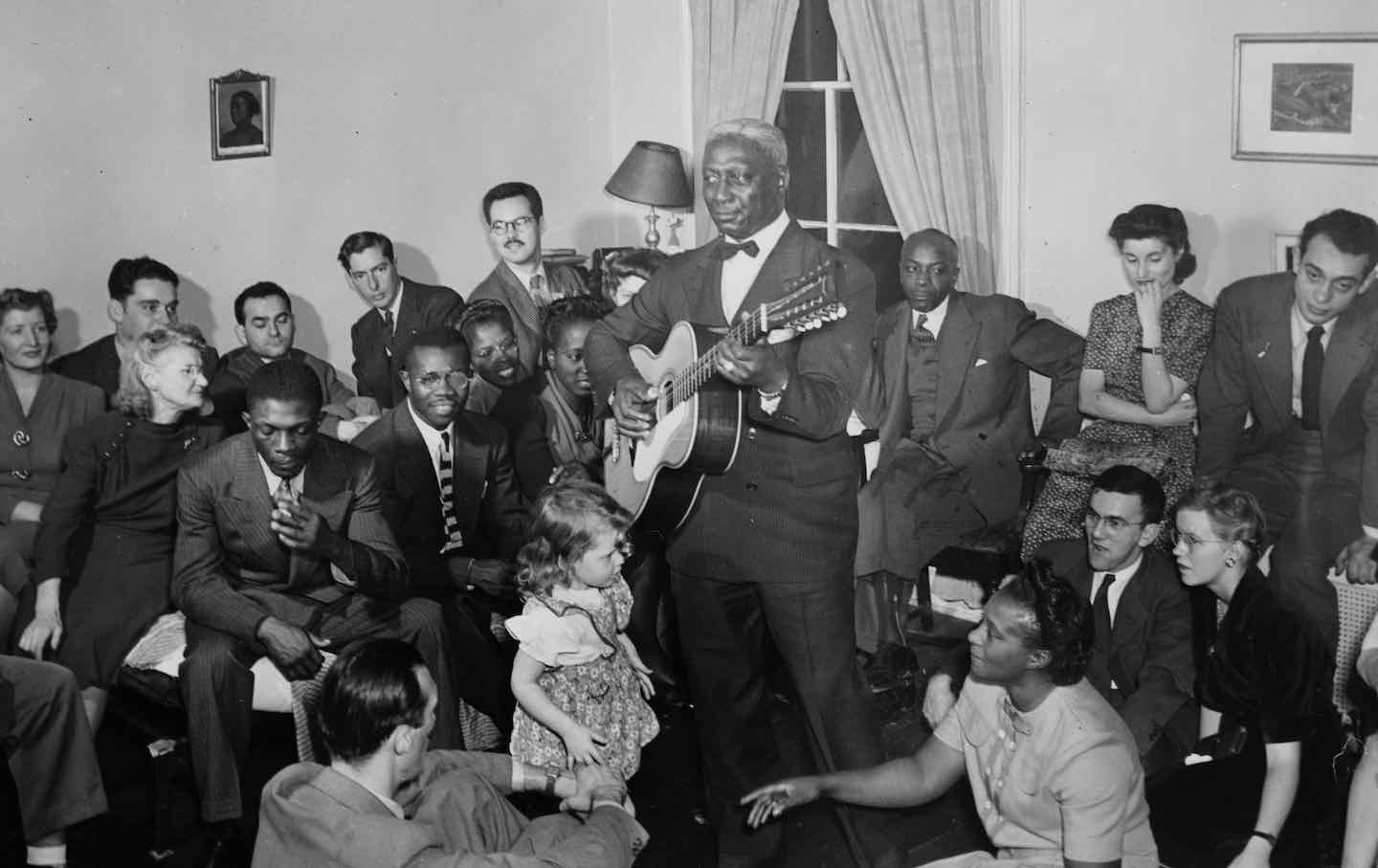Is the History of American Art a History of Failure?
Sara Marcus’s recent book argues that from the Reconstruction to the AIDS era, a distinct aesthetic formed around defeat in the realm of politics.

Little did he know, when Richard Wright walked into the Chicago John Reed Club in 1933, that he was walking into a “bitter factional fight” between the group’s painters and writers. Soon he’d find himself caught up in their power struggle for the club’s leadership, which mirrored a core political rift dividing the group. Wright had allied himself with the writers out of “simple loyalty,” and one night they called a special meeting to nominate him, over his objections, for the office of executive secretary. After an all-night debate, Wright was voted into office. It was only later that he realized the writers’ gambit: They were leftist intellectuals but not official members of the Communist Party—unlike the painters, who were CPUSA members. So the writers, he wrote, “confronted the members of the party with a Negro, knowing it would be difficult for Communists to refuse to vote for a man representing the largest single racial minority in the nation, inasmuch as Negro equality was one of the main tenets of Communism.” It was thus that the writers exploited Wright’s race and the ardent anti-racist goals of Communist politics to outmaneuver the painters.
Books in review
Political Disappointment: A Cultural History from Reconstruction to the AIDS Crisis
Buy this bookThis event took place in the early 1930s, a period designated by the Communist International as Third Period Communism. It was a period defined by the sense that capitalism was on the verge of collapse. This optimism in the imminence of worldwide revolution led Tillie Olsen to write with hope in 1934 of a coming “Soviet America.” In the Communist imaginary of the Third Period, it was the Black worker who would lead the coming revolution—hence the writers could put forth a Black candidate and bank on the Communists’ support. Within just a few years, Third Period Communism would come to an official end. Responding to the rise of fascism in Europe and the Great Depression in the United States, by the mid-1930s, the Communist left had mobilized its somewhat less orthodox, more coalitional Popular Front strategy. The shift from Third Period to Popular Front sought to enable broader alliances across the political left, but as Sara Marcus writes in her new book, Political Disappointment: A Cultural History From Reconstruction to the AIDS Crisis, the shift brought with it a “watering down of [the party’s] antiracist priorities” and a retreat from the celebratory feeling that revolution was around the corner. For those who held true to the promise of a Black revolutionary vanguard, the move to the “big tent” organizing strategy of the Popular Front constituted a loss of revolutionary vision, and the mid-1930s represented a period of political disappointment.
The central thesis of Marcus’s book is that for those seeking political transformation and social justice, the American post–Civil War era and the new century that followed unfolded as a series of such moments: windows of revolutionary promise that were abruptly, painfully closed. Reconstruction fell to Jim Crow; Third Period Communism yielded to the Popular Front; the classical phase of the civil rights movement faced persistent white terror; and so on. Wherever hope was raised, disappointment followed. Yet what is most striking about Marcus’s account is not so much her historical narrative but her implicit argument, mostly through the book’s methodology, about where these disappointments went and where the response to them can now be found: in the minute details of cultural expression.
While each of Marcus’s chapters sets the scene of political disappointment by providing historical context, her analysis takes the form of a series of intricate—and ingenious—close readings of works by W.E.B. Du Bois, Ella Sheppard, Tillie Olsen, Audre Lorde, David Wojnarowicz, and others. It is in the details of cultural production that Marcus locates the afterlife of disappointment, seeing in these details both grief for what was lost and the persistent desire for some ongoing, if reconfigured, version of it. If Political Disappointment makes an explicit case for recasting the 20th century as a century of disappointment, the real work of the book is to quietly build a case, through its method of analysis, for where grief and, ultimately, hope migrated: into the “fleeting and overlooked moments” of culture. Marcus illuminates these texts as repositories of political sentiment, where grief is processed and new solidarities are proposed.
In her chapter on 1930s Communism, for example, Marcus zeroes in on the work songs of Huddie Ledbetter, better known by his stage name Leadbelly. She notices a new, distinct vocalization that cropped up in his work songs in the late 1930s: a breathy huh added to the end of each line, a sonic representation of work, of axes falling, and of workers’ exhalations. This huh represented the cadence of labor. She pinpoints 1937 as the first recorded instance of Leadbelly’s enactment of this sound, in his recording of “Julie Ann Johnson” for the Library of Congress, and she observes that the sound grew more distinctly voiced in Leadbelly’s recordings over the next three years. Marcus sets this evolving huh in biographical context—by 1937, Leadbelly had moved to New York, where he became a favorite of leftist folk enthusiasts—and in the larger context of the shifting sands of revolutionary Communist discourse. To Marcus, it is no wonder that Leadbelly recorded his first huh in 1937, in the wake of the Third Period and the disappointments, especially when it came to the party’s “antiracist priorities,” of the Popular Front. For Leadbelly’s huh invoked the disappointment of the Popular Front and the very figure being lost from the party’s shifting priorities: the Black worker.
Music and musical transcription are ripe sites of analysis for Marcus, and her chapter on the failures of Reconstruction similarly focuses on how music made a record of political loss as well as the persistent hope for social transformation. She dives into Ella Sheppard’s transcriptions of Black spirituals for the Fisk Jubilee Singers, an a cappella group whose tours of the United States and Europe in the 1870s garnered the singers and their repertoire of songs much acclaim. Marcus makes a striking observation about the way Sheppard uses the fermata, a musical notation meant to indicate an unmetered pause. At a fermata, singers might hold a note longer, or they might go silent on it. In Sheppard’s transcription of the spiritual “O I’m Going to Sing All the Way,” Marcus notes that her fermatas sometimes ask singers to do both: They are distributed such that some singers are moving forward with a prolonged note, while others are stilled to silence. This choice by Sheppard, Marcus argues, creates a “halting, heterogenous quality” to the music, as though it were moving forward and backward at the same time. It is a sonic quality, Marcus extrapolates, that contravenes the period’s dominant narrative of history, the sense that “humanity was on an inexorable upward trajectory”—a demonstrably false narrative to the many Black Americans subject to the regressive terror and disenfranchisement of the period. Instead, the Fisk Jubilee Singers’ spirituals and Sheppard’s transcriptions posit a different way of thinking about history, indeed about time itself: Time does not move neatly forward; rather, past and present, movement and stillness, disappointment and hope are constitutively tangled up in each other.
Where music became a harbor for political sentiment in these cases, Marcus writes of a shift away from sound—and, in particular, voice—in the focus and rhetoric of second-wave feminism. The period from 1977 to 1983 was, in some ways, a bleak period for feminism, a period of right-wing backlash. Yet it was also a period when Black and intersectional feminism rose to prominence, naming the shortcomings and injustices both of second-wave (white) feminism and of Black liberation movements. While this period is often figured as one of decline and division, Marcus recasts it as one of feminist reassessment, particularly in light of Black feminism’s intersectional analysis. At the forefront of this reassessment was a shifting relationship to voice as an “article of feminist faith”: the notion that the root of women’s oppression lay in the suppression of their voices, and that the unleashing of women’s voices would undo their silencing and strike at the heart of patriarchy. But by the late 1970s, the raising of women’s voices had not achieved these goals. Moreover, for Black feminists, including Audre Lorde, whom Marcus spotlights, “speaking up” seemed insufficient for battling the racist and sexist ways that Black women were seen—how they had been “rendered invisible by the depersonalization of racism,” in Lorde’s words, and how visibility had made Black women “most vulnerable” but could yet serve as their “greatest strength.” Marcus argues that where voice had failed, leaving feminists disappointed, vision—seeing and being seen—stepped in as a new frontier of feminist poetics, theory, and strategy.
Marcus’s dazzling close readings go a long way toward supporting the idea that political disappointment quite literally “found form” in art, literature, and music, meaning as a place for these sentiments to lodge themselves. Marcus goes beyond merely placing the works in their historical contexts; she harvests historical contexts from within the works themselves. The almost invisible phenomena of culture—a huh from Leadbelly, a fermata from Sheppard—become indices of political history. Strung together, a new historical narrative emerges: “The story of the twentieth century is a story of disappointment.” So, too, does its cultural-historical correlative: that 20th-century art became the vehicle of disappointment’s expression, sometimes in the most surprising ways.
Immanent to Marcus’s analysis is perhaps another story: the story of how these political disappointments were processed in continued political mobilization. This is a story that the method of close reading is less able to accommodate, so it remains somewhat underexplored by Marcus. Surely, disappointment didn’t move strictly into the confines of culture but continued to circulate in politics as well. This is a facet that may be best reflected in the histories of social movements, but Marcus’s account does offer a taste of it, particularly in her chapter on the civil rights movement, which she focalizes through the 1966 March Against Fear.
In 1966, the activist James Meredith set out to walk across the state of Mississippi. His goal was to encourage Black Mississippians not to be afraid of white terror. When he was brutally attacked on the second day of his journey, an improvised coalition of activists, including Martin Luther King Jr. and Stokely Carmichael, came together to finish his walk. According to Marcus, 1966 was a year of disappointment for proponents of nonviolent civil disobedience; many, including the Student Nonviolent Coordinating Committee, then chaired by Carmichael, were questioning the goals and the tactics of the civil rights movement. She maps the tension of this moment—and the shifting tactics of Black liberation—in the soundscape of the march: Carmichael and SNCC unveiled their new Black Power chant, but King and his proponents were still using the movement’s traditional songs. In the sonic cacophony of conflicting ideology, the tenuous coalition decided to go quiet, neither to chant nor to sing but just to walk. We see in Marcus’s analysis the way disappointment seeded a new political dispensation—Black Power—and how this political shift was configured in artistic expression.
What feels lasting and applicable about Marcus’s exploration of 20th-century political disappointment is her definition of disappointment itself. Disappointment is distinct from disillusionment, or the “bitter or sheepish pronouncements that one’s desires, misbegotten from the start, [are] suitable only for disavowal.” Instead, as Marcus sees it, disappointment is fundamentally generative. As her book testifies, it is behind some of the 20th century’s most important works of culture, from Du Bois’s Souls of Black Folk to the poetry and prose of Lorde. It is also the engine behind the new, if tenuous, solidarities that emerge in the wake of these disappointments—the way intersectional feminists found new traction in the concept of visibility, or how the art and activism of the AIDS crisis (such as the work of Marlon Riggs and David Wojnarowicz) ushered into being coalitions that included those who had died. In all of the instances Marcus studies, we see artists refusing to disavow what they were fighting for, even if the conditions of possibility for achieving their goals had been dismantled—by white supremacy or capitalism or patriarchy. They may have been disappointed, but they weren’t disillusioned. Shall we all strive, then, to be disappointed.
Disobey authoritarians, support The Nation
Over the past year you’ve read Nation writers like Elie Mystal, Kaveh Akbar, John Nichols, Joan Walsh, Bryce Covert, Dave Zirin, Jeet Heer, Michael T. Klare, Katha Pollitt, Amy Littlefield, Gregg Gonsalves, and Sasha Abramsky take on the Trump family’s corruption, set the record straight about Robert F. Kennedy Jr.’s catastrophic Make America Healthy Again movement, survey the fallout and human cost of the DOGE wrecking ball, anticipate the Supreme Court’s dangerous antidemocratic rulings, and amplify successful tactics of resistance on the streets and in Congress.
We publish these stories because when members of our communities are being abducted, household debt is climbing, and AI data centers are causing water and electricity shortages, we have a duty as journalists to do all we can to inform the public.
In 2026, our aim is to do more than ever before—but we need your support to make that happen.
Through December 31, a generous donor will match all donations up to $75,000. That means that your contribution will be doubled, dollar for dollar. If we hit the full match, we’ll be starting 2026 with $150,000 to invest in the stories that impact real people’s lives—the kinds of stories that billionaire-owned, corporate-backed outlets aren’t covering.
With your support, our team will publish major stories that the president and his allies won’t want you to read. We’ll cover the emerging military-tech industrial complex and matters of war, peace, and surveillance, as well as the affordability crisis, hunger, housing, healthcare, the environment, attacks on reproductive rights, and much more. At the same time, we’ll imagine alternatives to Trumpian rule and uplift efforts to create a better world, here and now.
While your gift has twice the impact, I’m asking you to support The Nation with a donation today. You’ll empower the journalists, editors, and fact-checkers best equipped to hold this authoritarian administration to account.
I hope you won’t miss this moment—donate to The Nation today.
Onward,
Katrina vanden Heuvel
Editor and publisher, The Nation
More from The Nation

Rob Reiner’s Legacy Can't Be Sullied by Trump’s Shameful Attacks Rob Reiner’s Legacy Can't Be Sullied by Trump’s Shameful Attacks
The late actor and director leaves behind a roster of classic films—and a much safer and juster California.

Blood Orange’s Sonic Experiments Blood Orange’s Sonic Experiments
Dev Hynes moves between grief and joy in Essex Honey, his most personal album yet.

Ars Poetica with Backup from The Clark Sisters Ars Poetica with Backup from The Clark Sisters
after “Is My Living in Vain?”, 1980

Helen DeWitt and Ilya Gridneff’s Sweeping Anti-War Novel Helen DeWitt and Ilya Gridneff’s Sweeping Anti-War Novel
Your Name Here dramatizes the tensions and possibilities of political art.


